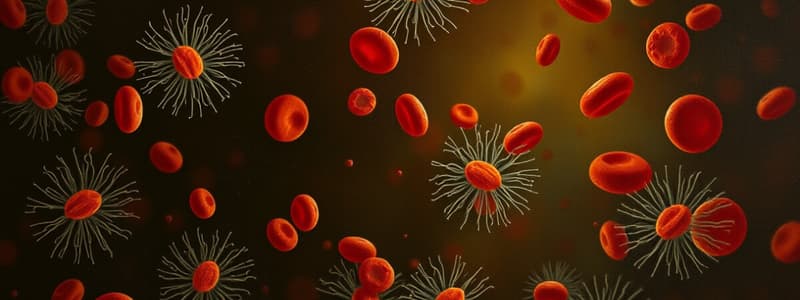Podcast
Questions and Answers
What function is NOT associated with basophils?
What function is NOT associated with basophils?
- Allergic reactions
- Inflammation
- Phagocytosis (correct)
- Anti-infection
Which cells mature in the thymus gland?
Which cells mature in the thymus gland?
- Macrophages
- B lymphocytes
- T-cells (correct)
- Monocytes
Which statement about macrophages is true?
Which statement about macrophages is true?
- They recognize viral infections only.
- They function in the tissues. (correct)
- They are derived from basophils.
- They are the smallest cells in blood.
What is the primary role of CD8 T lymphocytes?
What is the primary role of CD8 T lymphocytes?
Opsonization aids the immune system by doing what?
Opsonization aids the immune system by doing what?
Which granulocyte is primarily characterized by a kidney-shaped nucleus?
Which granulocyte is primarily characterized by a kidney-shaped nucleus?
What is the last stage of granulocyte maturation that is capable of cell division?
What is the last stage of granulocyte maturation that is capable of cell division?
Which type of granules is associated with the promyelocyte stage of granulocyte differentiation?
Which type of granules is associated with the promyelocyte stage of granulocyte differentiation?
What is the primary function of the marginated neutrophil pool?
What is the primary function of the marginated neutrophil pool?
Which of the following statements about myeloblasts is true?
Which of the following statements about myeloblasts is true?
Flashcards are hidden until you start studying
Study Notes
Leukocytes Overview
- Neutrophils are the most abundant type of white blood cells (WBCs) and are produced in the bone marrow.
Granulocytes
- Myeloblast Stages:
- Type I Myeloblast: no visible granules.
- Type II Myeloblast: developing azurophilic granules in the Golgi apparatus.
- Type III Myeloblast: characterized by darker chromatin and purple cytoplasm, often associated with myeloid leukemia.
- Normal promyelocytes display a paranuclear halo, unlike abnormal promyelocytes.
- Promyelocytes contain 2-3 nucleoli, which form primary granules.
- Myelocytes are the last stage of granulocyte maturation capable of cell division and contain secondary granules.
- Metamyelocytes have a kidney-shaped nucleus and are the precursors of neutrophils; they contain tertiary granules.
Neutrophil Pools
- Marginated Neutrophil Pool: found in localized areas such as the liver, spleen, or lungs.
- Circulated Neutrophil Pool: a source of cytokines and assists in Vitamin B12 absorption.
Granules Composition
- Primary (Azurophilic) Granules: found in promyelocytes; contain myeloperoxidase and defensins.
- Secondary (Specific) Granules: found in myelocytes; include proteins like lactoferrin and gelatinase.
- Tertiary Granules: found in metamyelocytes and bands; contain b2-microglobulin and acetyltransferase.
Eosinophils and Basophils
- Charcot-Leyden crystals can be used to identify eosinophils through cytochemical staining.
- Basophils are the rarest WBCs (0-1%) and are involved in allergic reactions and inflammation.
- Mast cells, found in tissues, function similarly to basophils but are not classified as WBCs.
Agranulocytes
- Monocytes are the largest cells observed in peripheral blood smears and differentiate into macrophages in tissues.
- Macrophages play a crucial role in recognizing bacterial pathogens and participating in adaptive immunity through phagocytosis.
Immune Response
- Opsonization enhances the immune system's ability to identify and destroy pathogens or old cells.
- T-cells mature in the thymus gland; B lymphocytes are produced and mature in the bone marrow.
- Humoral immunity involves the production of antibodies.
- T Lymphocytes:
- CD4 cells help in antibody production.
- CD8 cells are responsible for cytotoxic functions.
- T Lymphocytes:
Lymphocyte Recirculation
- Lymphocytes circulate continuously through blood and tissues, aiding in immune surveillance.
Studying That Suits You
Use AI to generate personalized quizzes and flashcards to suit your learning preferences.



